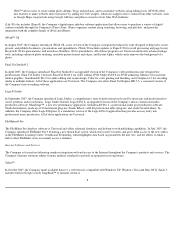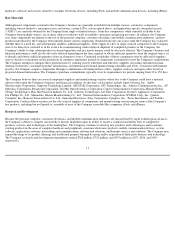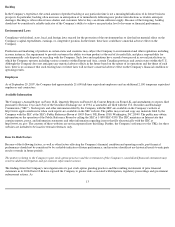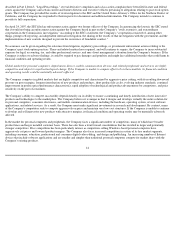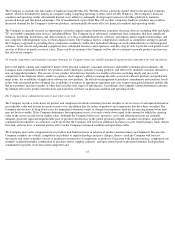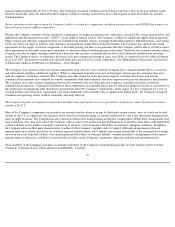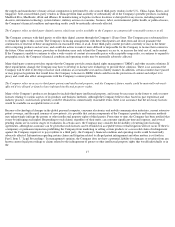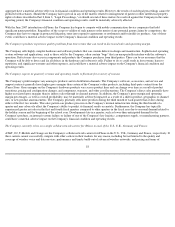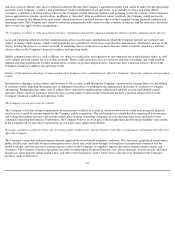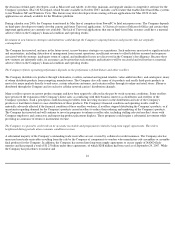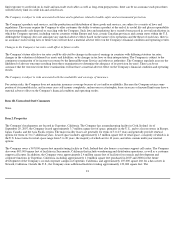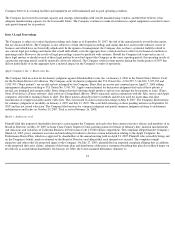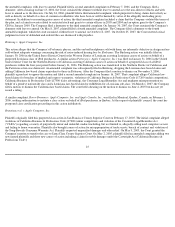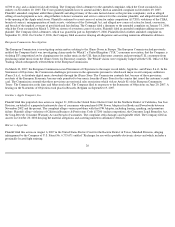Apple 2007 Annual Report Download - page 19
Download and view the complete annual report
Please find page 19 of the 2007 Apple annual report below. You can navigate through the pages in the report by either clicking on the pages listed below, or by using the keyword search tool below to find specific information within the annual report.
manufacturing requirements for 30 to 150 days. The Company's financial condition and operating results have been in the past and may in the
future be materially adversely affected by the Company's ability to manage its inventory levels and respond to short-term shifts in customer
demand patterns.
Future operating results depend upon the Company's ability to obtain key components, including microprocessors and NAND flash memory, at
favorable prices and in sufficient quantities.
Because the Company currently obtains certain key components, including microprocessors, enclosures, certain LCDs, certain optical drives, and
application-specific integrated circuits ("ASICs"), from single or limited sources, the Company is subject to significant supply and pricing risks.
Many of these and other key components that are available from multiple sources, including NAND flash memory, DRAM memory, and certain
LCDs, are subject at times to industry-wide shortages and significant commodity pricing fluctuations. The Company has entered into certain
agreements for the supply of critical components at favorable pricing, but there is no guarantee that the Company will be able to extend or renew
these agreements on favorable terms upon expiration or otherwise obtain favorable pricing in the future. Therefore, the Company remains subject
to significant risks of supply shortages and/or price increases that can have a material adverse effect on its financial condition and operating
results. The Company expects to experience decreases in its gross margin percentage in fiscal year 2008, as compared to levels achieved during
fiscal year 2007, due in part to current and expected future price increases for certain components. See "Management's Discussion and Analysis
of Financial Condition and Results of Operations—Gross Margin."
The Company's new products often use custom components from only one source until the Company has evaluated whether there is a need for,
and subsequently qualifies, additional suppliers. Where a component or product uses new technologies, initial capacity constraints may exist
until the suppliers' yields have matured. The Company and other producers in the personal computer, consumer electronics and mobile
communication industries also compete for various components with other industries that have experienced increased demand for their products.
The Company uses some custom components that are not common to the rest of the personal computer, consumer electronics or mobile
communication industries. Continued availability of these components at acceptable prices may be affected if producers decide to concentrate on
the production of components other than those customized to meet the Company's requirements. If the supply of a key component for a new or
existing product were delayed or constrained, or if such components were available only at significantly higher prices, the Company's financial
condition and operating results could be materially adversely affected.
The Company depends on component and product manufacturing and logistics services provided by third parties, many of whom are located
outside of the U.S.
Most of the Company's components and products are manufactured in whole or in part by third-party manufacturers, most of which are located
outside of the U.S. A significant concentration of this outsourced manufacturing is currently performed by only a few third-party manufacturers,
often in single locations. The Company has also outsourced much of its transportation and logistics management. While these arrangements may
lower operating costs, they also reduce the Company's direct control over production and distribution. It is uncertain what effect such diminished
control will have on the quality or quantity of products or services, or the Company's flexibility to respond to changing conditions. In addition,
the Company relies on third-party manufacturers to adhere to the Company's supplier code of conduct. Although arrangements with such
manufacturers may contain provisions for warranty expense reimbursement, the Company may remain responsible to the consumer for warranty
service in the event of product defects. Any unanticipated product defect or warranty liability, whether pursuant to arrangements with contract
manufacturers or otherwise, could have a material adverse effect on the Company's reputation, financial condition and operating results.
Final assembly of the Company's products is currently performed in the Company's manufacturing facility in Cork, Ireland, and by external
vendors in California, Korea, China and the Czech Republic. Currently,
16




